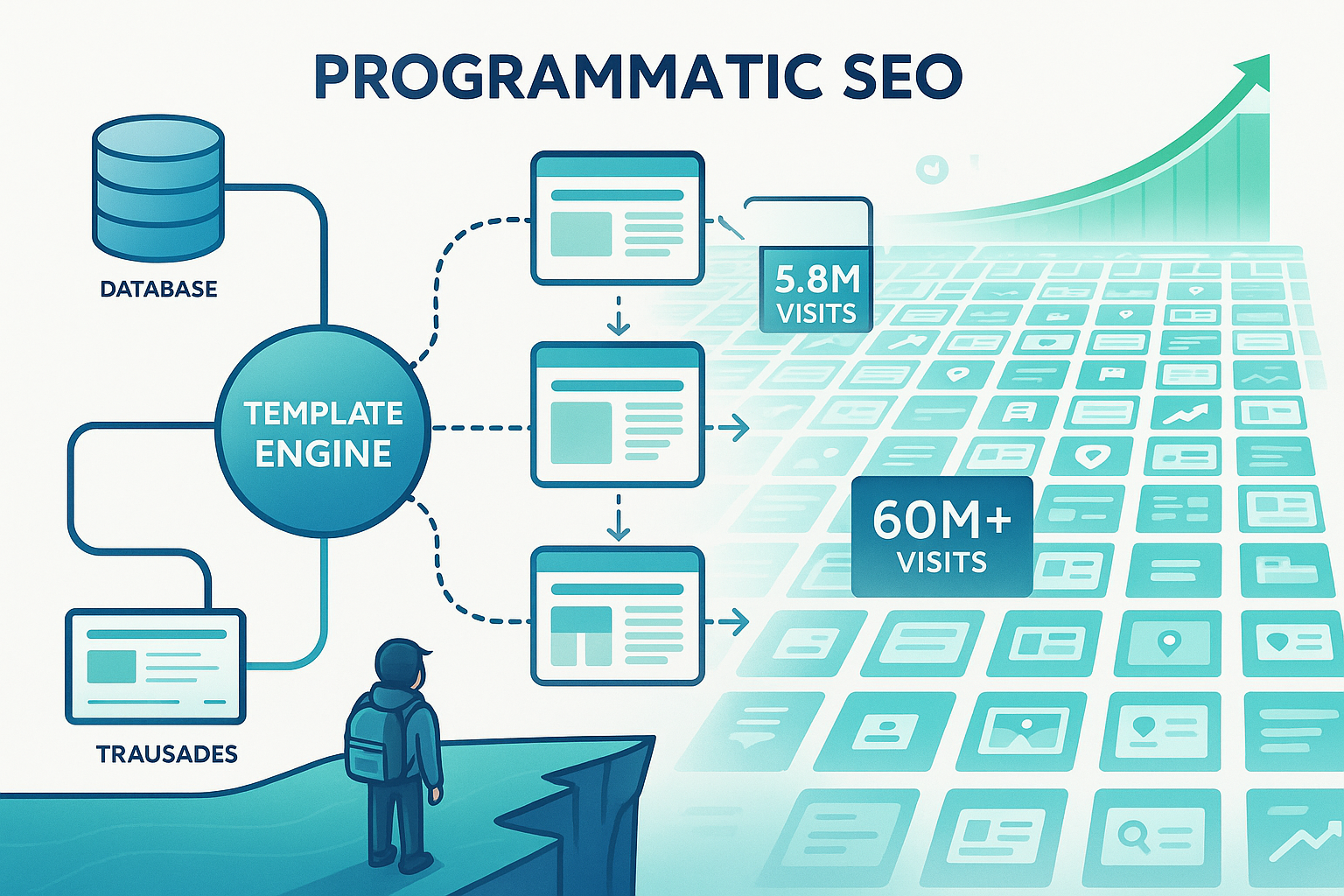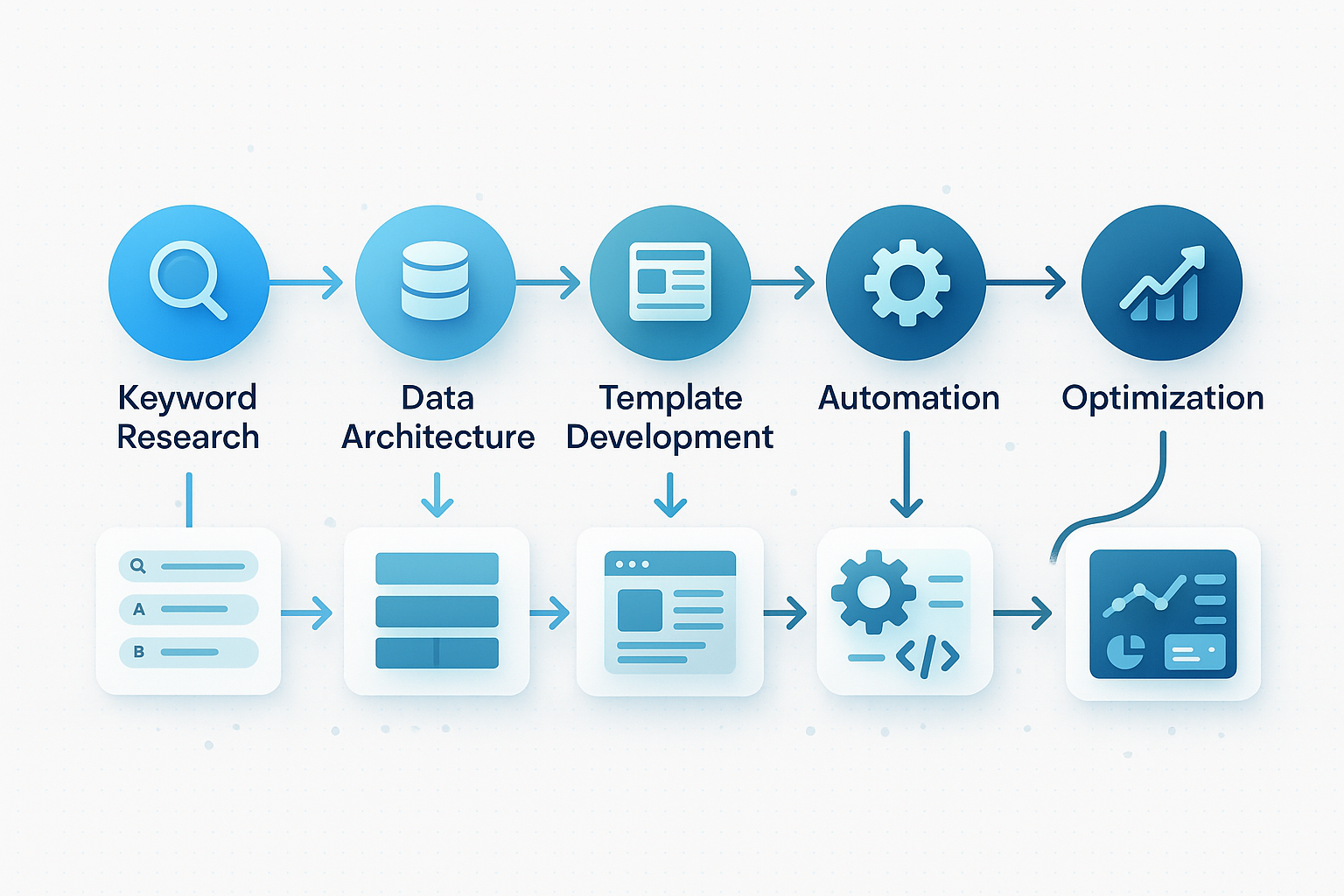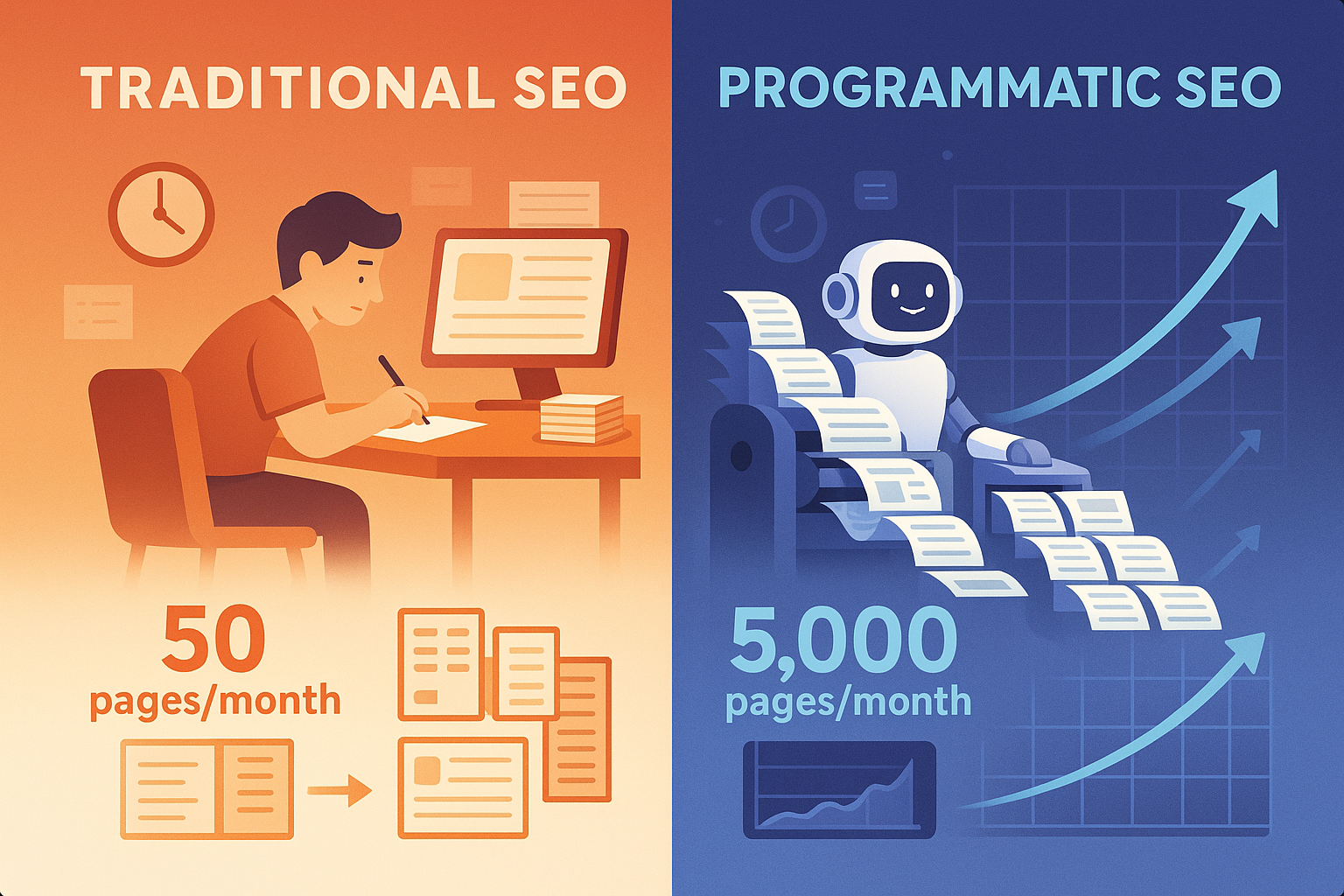The Complete Guide to Programmatic SEO
Programmatic SEO has emerged as the most powerful strategy for scaling organic traffic. Companies like Zapier (5.8M monthly visits) and Wise (60M+ visits) use automated page creation to dominate search results. This guide reveals how to implement programmatic SEO for exponential traffic growth.

Programmatic SEO has emerged as one of the most powerful strategies for scaling organic traffic in the digital age. Companies like Zapier (5.8M monthly organic visits), Wise (60M+ monthly visits), and TripAdvisor (226M+ monthly visits) have used programmatic SEO to dominate their respective markets by creating thousands of pages that collectively capture massive search volume. This comprehensive guide reveals how programmatic SEO works, why it's so effective, and how to implement it successfully.
What is programmatic SEO: The foundation of scalable content
Programmatic SEO is the automated or semi-automated creation of keyword-targeted pages at scale using templates, structured data, and automation tools. Unlike traditional SEO that focuses on creating 10-50 manually crafted pages, programmatic SEO generates hundreds to thousands of pages targeting long-tail keyword variations.
The core concept revolves around the "head term + modifier" approach. For example, Wise creates pages targeting "USD to EUR," "GBP to USD," and thousands of other currency conversion combinations. Each page follows the same template but serves a specific search intent with unique data.
How programmatic SEO differs from traditional SEO
The fundamental differences lie in scale, automation, and strategic focus:
Traditional SEO targets high-volume, competitive keywords requiring significant authority to rank. It involves labor-intensive manual content creation, with each page receiving individual attention from writers and editors. The approach typically focuses on informational content designed to build brand awareness and authority.
Programmatic SEO targets low-competition, long-tail keywords that collectively generate substantial traffic. It uses template-based content generation powered by structured data, with automated or semi-automated processes handling most of the work. The strategic focus centers on transactional and commercial intent keywords that drive conversions.
Example:
-> A traditional SEO approach might create one comprehensive "Best Project Management Software" guide targeting a high-competition keyword.
--> A programmatic SEO approach would create hundreds of pages like "Best Project Management Software for Small Teams," "Best Project Management Software for Agencies," and "Best Project Management Software for Remote Work" - each targeting specific long-tail variations with lower competition but high commercial intent.
The conceptual framework behind programmatic success
Programmatic SEO operates on the "Long-Tail Aggregation Theory" - while individual long-tail keywords have low search volumes, collectively they represent massive traffic opportunities. The framework separates structure (templates) from content (data), enabling infinite variations while maintaining quality and consistency.
This approach prioritizes intent-driven architecture over keyword-focused optimization. Rather than stuffing keywords into content, programmatic SEO creates pages that precisely match specific user intents at scale. The philosophy emphasizes providing unique, relevant data rather than just content volume - successful sites like Zapier and Wise succeed because they offer genuinely useful information in formats that serve users' immediate needs.
How programmatic SEO works: The technical engine
The technical implementation of programmatic SEO follows a systematic five-phase process that combines automation with strategic planning to generate high-quality pages at scale.

Phase 1: Strategic foundation and keyword research
Keyword research at scale forms the foundation of any successful programmatic SEO campaign. The process begins by identifying "head terms" (broad categories like "hotels," "restaurants," or "software") and "modifiers" (specific variations like location names, features, or use cases).
The goal is generating 1,000-100,000+ keyword variations using the formula: [head term] + [primary modifier] + [secondary modifier].
For example, "restaurants" + "in Boston" + "for date night" creates a specific long-tail keyword with commercial intent.
Tools like SEMrush's Keyword Magic Tool, Ahrefs Keywords Explorer, or Ubersuggest help identify these patterns. The key is targeting keywords with 10-1,000 monthly searches where competition remains manageable but collective volume justifies the automation investment.
Phase 2: Data architecture and technical setup
Database design becomes critical when managing thousands of pages. Successful implementations use relational databases (MySQL, PostgreSQL) for complex data relationships or NoSQL solutions (MongoDB) for varying schema requirements. Companies like Wise built custom content management systems specifically for programmatic SEO scalability.
The technical architecture must support hierarchical URL structures, efficient crawl paths, and optimized sitemap management. Site architecture planning ensures important pages remain within 3-4 clicks from the homepage while maintaining logical content organization.
Phase 3: Template development and content generation
Template architecture separates static elements (consistent across all pages) from dynamic placeholders (populated from databases). Successful templates include essential SEO elements like title tags, meta descriptions, structured data markup, and internal linking opportunities.
The content generation workflow combines proprietary data with public datasets, implementing validation processes to ensure quality. Companies often layer multiple data types - specifications, reviews, local information, and historical data - to create comprehensive pages that provide genuine value beyond basic data display.
Phase 4: Automation and publishing workflows
CMS integration varies by platform and technical requirements. WordPress implementations often use WP All Import for CSV integration, while Webflow leverages CMS APIs with tools like Whalesync for database synchronization. Custom solutions develop API integrations for real-time data updates.
The publishing process emphasizes gradual rollout rather than mass publication. Successful campaigns start with 10-20 pages, then gradually increase to 50-100 weekly to monitor performance and avoid algorithmic flags.
Phase 5: Quality assurance and optimization
Multi-stage review processes ensure content quality at scale. This includes template validation for SEO optimization, data quality audits for accuracy and completeness, and sample page testing before full deployment. Automated quality checks detect duplicate content, broken links, and formatting issues.
Ongoing monitoring tracks performance metrics, content freshness, and technical health. Companies implement automated systems for detecting 404 errors, broken links, and indexing issues while collecting user feedback for continuous improvement.
Key use cases and industry success stories
Programmatic SEO applications span diverse industries, with each vertical developing unique approaches based on their data assets and user needs.
SaaS industry: Integration and comparison dominance
Zapier exemplifies SaaS programmatic SEO excellence with over 50,000 integration landing pages generating 5.8M+ monthly organic visits. Their two-pronged strategy creates app profile pages and specific app-to-app integration pages, with partner-generated content during onboarding ensuring scalability.
UserPilot achieved remarkable efficiency, producing 29 blog posts per hour using programmatic templates. Their Excel-based database powered comparison articles and tool reviews, driving traffic growth from 25K to 100K monthly organic visitors in 10 months - a 4x improvement in growth rate.
KrispCall demonstrated geographic programmatic SEO with area code landing pages, achieving 1,969% year-over-year growth. Their area code pages generated 82% of all US traffic during the analysis period, showing how location-based programmatic content can dominate specific market segments.
Travel and hospitality: Location-based content engines
TripAdvisor operates one of the largest programmatic SEO implementations with 700M+ indexed pages generating 226M+ monthly organic visits. Their strategy encompasses "Things to do in {place}" pages, hotel listings, and restaurant guides, all powered by massive user-generated content databases.
Nomad List targets digital nomads with 24,000+ city pages covering cost of living, internet speeds, and lifestyle factors. Despite their niche focus, they generate 43.2K+ monthly organic visits with highly engaged users who often convert to paid memberships.
Airbnb's "Holiday Rentals in [City]" approach demonstrates how accommodation platforms use location-based templates with real-time availability data to dominate local search results across thousands of destinations.
E-commerce and directories: Product and service scalability
Canva generated 2.2M+ template pages ranking for 500K+ keywords, with 80K+ ranking in top 3 positions. Their template-based approach creates specific pages for every design use case, generating 1.3M+ estimated monthly organic visits from programmatic content.
Yelp's local business directory approach generates 135M+ monthly visits by creating automated pages for every business listing with reviews, ratings, and photos. Their revenue model combines local advertising with lead generation, demonstrating programmatic SEO's commercial viability.
Financial services: Data-driven market domination
Wise (formerly TransferWise) achieved 60M+ monthly organic visits through currency conversion pages and bank SWIFT code pages. Their custom CMS "Lienzo" was built specifically for programmatic SEO, enabling content production of ~300 articles per quarter across multiple languages.
The company successfully maintained traffic during their 2021 domain migration from transferwise.com to wise.com, demonstrating the resilience of well-implemented programmatic SEO strategies.
Real estate: Geographic and property-based scaling
Flyhomes grew from 10K to 425K pages in three months, with cost of living guides generating 55.5% of site traffic (1.1M+ monthly visits). Their rapid scaling demonstrates how real estate platforms can leverage location and property data for programmatic content.
Zillow dominates real estate searches through location-specific pages covering zip codes, cities, and streets across America, combining market data with property listings and neighborhood information.
The magic of programmatic SEO: Scalability and compound growth
The transformative power of programmatic SEO lies in its "efficiency multiplier effect" - one template can generate thousands of pages, creating exponential returns on initial investment. This scalability advantage becomes particularly compelling when examining the compound growth effects successful implementations achieve.
The scalability advantage: From dozens to millions
Traditional SEO approaches face inherent scaling limitations. Creating 100 high-quality, manually crafted pages requires substantial resources - writers, editors, SEO specialists, and ongoing optimization efforts. The linear relationship between input and output makes scaling expensive and time-intensive.
Programmatic SEO breaks this linear constraint through systematic automation. Once templates and data pipelines are established, generating additional pages requires minimal marginal cost. Wise's 4M+ indexed URLs and TripAdvisor's 700M+ pages demonstrate scales impossible through traditional methods.
The front-loaded investment model differs fundamentally from traditional approaches. While initial setup requires significant technical and strategic investment, ongoing page generation becomes increasingly efficient. Companies report production rates like UserPilot's 29 blog posts per hour, showcasing the dramatic efficiency gains.
Compound growth effects: The exponential traffic multiplier
Successful programmatic SEO implementations exhibit compound growth patterns that accelerate over time. Each new page adds to the site's overall authority while targeting specific long-tail keywords. As pages begin ranking and attracting backlinks, the entire programmatic section benefits from increased domain authority.
Network effects amplify individual page performance. Internal linking between programmatic pages creates content clusters that reinforce topical authority. Users discovering one page often navigate to related pages, creating engagement signals that boost rankings across the entire programmatic section.
Transit App's 1,134% year-over-year growth exemplifies these compound effects. Their expansion from 300 to 21K pages in 2023 created momentum that accelerated traffic growth beyond what individual page performance would suggest.
Coverage optimization: Capturing the invisible demand
Programmatic SEO enables comprehensive market coverage that reveals hidden demand patterns. Long-tail keywords individually show low search volumes, but collectively represent substantial traffic opportunities that competitors often overlook.
The "invisible demand" phenomenon occurs when programmatic pages rank for keywords that keyword research tools underestimate. Real user search behavior includes countless variations and combinations that aggregate search volume data misses. Successful programmatic implementations often discover their pages ranking for thousands of unexpected keyword variations.
Market share capture happens systematically rather than competitively. Instead of fighting for high-competition keywords, programmatic SEO claims uncontested territory in long-tail search results. This approach builds sustainable competitive advantages that remain difficult for competitors to replicate.
Technical momentum: Infrastructure advantages
Well-implemented programmatic SEO creates technical momentum that benefits the entire domain. Large volumes of quality content improve crawl frequency, indexing speed, and overall search engine relationship quality. Sites with successful programmatic sections often see improvements in their non-programmatic content performance.
Authority distribution occurs as programmatic pages accumulate backlinks and engagement signals. This authority flows throughout the site architecture, boosting rankings for both programmatic and traditional content. The scale advantage creates authority building opportunities unavailable to smaller implementations.
How to excel at programmatic SEO for quality traffic
Success in programmatic SEO requires balancing automation efficiency with content quality while avoiding common pitfalls that can trigger search engine penalties or create poor user experiences.
Quality-first implementation strategies
The "human test" principle should guide every programmatic SEO decision: would you manually create each page if resources weren't constrained? Pages that fail this test likely provide insufficient value and risk algorithmic penalties.
Unique value proposition development ensures each page offers something competitors don't provide. Successful programmatic pages combine multiple data points - specifications, reviews, local information, historical data - creating comprehensive resources that justify their existence beyond keyword targeting.
Content depth strategies prevent thin content issues through multi-layered information architecture. Real-time data integration using APIs provides dynamic value, while user-generated content like reviews and Q&A adds unique perspectives that differentiate pages from competitors.
Avoiding common implementation pitfalls
Thin content represents the primary risk in programmatic SEO implementations. Google's Panda algorithm specifically targets low-quality content, making content depth essential. Establish minimum content thresholds (typically 300+ words) while ensuring substance over length.
Mass publishing triggers algorithmic scrutiny and potential manual reviews. Successful implementations use drip publishing strategies - starting with 10-20 pages, then gradually increasing to 50-100 weekly based on performance monitoring.
Inadequate internal linking creates orphaned pages that search engines struggle to discover and users can't navigate effectively. Design systematic internal linking strategies that connect related programmatic pages while distributing authority throughout the content network.
Quality control and monitoring systems
Multi-stage review processes ensure consistent quality at scale. Template validation confirms SEO optimization and user experience standards. Data quality audits verify accuracy, completeness, and relevance of source information. Sample page testing identifies issues before full deployment.
Performance tracking systems monitor key quality indicators: bounce rates, time on page, conversion rates, and search performance metrics. Declining engagement signals often indicate quality issues requiring template or data improvements.
Content freshness maintenance prevents programmatic pages from becoming outdated. Implement automated systems for updating time-sensitive information while scheduling regular reviews for accuracy and relevance.
Technical excellence for sustainable growth
Site architecture optimization becomes critical when managing thousands of pages. Hierarchical URL structures, optimized crawl paths, and efficient sitemap management ensure search engines can effectively index large programmatic implementations.
Performance optimization maintains user experience standards across all programmatic pages. Content Delivery Networks (CDNs), image compression, caching strategies, and mobile-first responsive design prevent scale from compromising page speed.
Crawl budget optimization ensures search engines prioritize important pages over low-value content. Strategic robots.txt configuration, internal linking hierarchies, and sitemap organization guide crawler attention to high-value programmatic content.
Balancing quantity with quality metrics
Quality-first scaling prioritizes sustainable growth over rapid page generation. Start with smaller implementations that demonstrate value, then scale based on performance data rather than arbitrary targets.
Tier-based content strategies create different quality levels for different keyword values. High-value keywords receive premium detailed pages, while long-tail terms get lighter but still valuable content that serves specific user intents.
User feedback integration provides quality signals that automated monitoring might miss. Comments, reviews, and user testing identify content gaps and improvement opportunities that enhance both user satisfaction and search performance.
Leveraging internal data and premium sources for programmatic advantage
The most successful programmatic SEO implementations combine internal business data with premium external sources to create unique, valuable content that competitors cannot easily replicate.
Google Search Console data: Your hidden keyword goldmine
GSC API integration enables automated extraction of search performance data, queries, clicks, impressions, and CTR metrics that reveal programmatic opportunities invisible in traditional keyword research tools.
Query pattern analysis identifies repeatable keyword structures already driving traffic to your site. Look for patterns like "[head term] + [location]" or "[product] + [use case]" in your existing GSC data. These patterns often reveal thousands of variations you're not yet targeting.
Performance optimization workflows use GSC data to identify low-CTR, high-impression pages that could benefit from programmatic scaling. If one page receives impressions for hundreds of related keywords, those variations likely represent programmatic opportunities.
Index status monitoring through GSC's URL Inspection API helps track programmatic page indexing at scale, identifying technical issues that might prevent proper crawling and indexing of large page sets.
Internal business data: Your competitive moat
Customer behavior data provides unique insights for content generation that external tools cannot match. Analyze customer journey data to create targeted landing pages for different user segments, geographic regions, or behavioral patterns.
Product and service data utilization creates programmatic opportunities directly tied to business offerings. SaaS companies generate integration pages for every possible tool combination, while service businesses create location-specific pages using internal service area data.
Geographic and demographic targeting uses internal customer data to create region-specific content variations that serve local search intent while leveraging unique business insights about different markets.
Premium data sources and APIs
SEO-specific APIs like DataForSEO, SEMrush API, and Ahrefs API provide comprehensive SERP data, keyword research, and competitor analysis capabilities that enable sophisticated programmatic strategies based on real competitive intelligence.
Industry-specific datasets create competitive advantages through unique data access. Government APIs like USDA datasets (6,000+ datasets available), census data, and economic indicators provide authoritative information for content generation.
Real-time data integration through APIs like Google Places, OpenWeather, or financial market data creates dynamic content that updates automatically, providing ongoing value that static competitors cannot match.
Strategic data combination techniques
Multi-source data layering combines internal business data with external premium sources to create comprehensive content that serves multiple user intents. Successful implementations often integrate 3-5 different data sources per page template.
Data validation and quality assurance processes ensure accuracy and completeness across all data sources. Implement automated checks for data freshness, accuracy, and completeness while maintaining fallback systems for API failures or data gaps.
Competitive intelligence integration uses premium data sources to identify content gaps in competitor programmatic implementations, revealing opportunities for differentiation and market capture.
The most successful programmatic SEO implementations treat data as their core competitive advantage, investing in unique data sources and sophisticated integration capabilities that create sustainable differentiation in search results. Companies that excel at programmatic SEO often develop proprietary data advantages that become increasingly difficult for competitors to replicate over time.
Conclusion: Building your programmatic SEO advantage
Programmatic SEO represents a fundamental shift from manual, artisanal content creation to systematic, data-driven page generation that can achieve remarkable scale when implemented with proper strategic planning and quality oversight. The companies dominating search results today - Zapier, Wise, TripAdvisor, and others - understand that programmatic SEO isn't about gaming search engines but about serving user intent at scale through intelligent automation.

Success requires balancing three critical elements: technical excellence, content quality, and strategic data utilization. The technical infrastructure must handle thousands of pages without performance degradation. Content quality must provide genuine value that justifies each page's existence. Data strategy must create unique competitive advantages through proprietary information or sophisticated external source integration.
The compound growth effects of well-executed programmatic SEO create sustainable competitive advantages that become increasingly difficult for competitors to replicate. As your programmatic pages accumulate authority, generate backlinks, and improve user engagement signals, they create momentum that accelerates organic growth across your entire domain.
Start strategically with smaller implementations that demonstrate value before scaling to thousands of pages. Focus on quality over quantity, user value over keyword targeting, and sustainable growth over rapid expansion. The companies achieving massive success with programmatic SEO treat it as a sophisticated content strategy rather than a quick traffic hack.
The future belongs to businesses that can combine automation efficiency with human insight, creating programmatic content that genuinely serves users while achieving the scale necessary to dominate search results in their markets. Master programmatic SEO now, and you'll build traffic generation systems that compound in value over time while your competitors struggle with the limitations of traditional, manual approaches.

